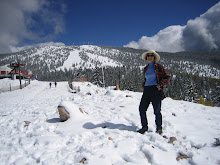Camino Real - Pancho Villa Territory!

Saturday, March 3
By 8:30 a.m., all 40 of us are in the bus. Today’s destination is Parral. First we must get out of the city, no small feat in the morning traffic. Chihuahua goes on and on. We pass a park that was formerly the city limits. Luis points out “the House of Tears” on one corner. Apparently, the family’s son gambled the house away one ill-fated evening. In the morning his sisters and widowed mother awoke to find that they no longer had a place to live. They spent the rest of their days in bitter mourning.
We come to Chihuahua’s beautiful stone aqueduct, where we get out and take pictures. Our meandering over at last, we cross the city limit and head south to Parral. The road descends into rolling hills. We wind through many curvas peligrosas. On either side, cattle are grazing. Stone walls mark the cultivated fields and climb the hills, often dividing a hill in half. A team of cyclists in red jerseys speed by. Hal says that we’ll soon be coming to the main towns of Spanish colonization. We stop at Satevo and walk to a Jesuit church, white on the outside and quite plain inside.
When we’re back on the bus, Hal tells us about Adolph Wislizenus, a scientist-doctor who accompanied Albert Speyer from Missouri into Mexico. Two wagons of the caravan held rifles to be delivered to the governor of Chihuahua. Along with other Americans, Wislizenus managed to get arrested and sent to Cusihuiriachic in the fall of 1846. Rather than being thrown into jail, however, “the Wiz” and others were under a kind of house arrest that allowed exploration of the area. Thus resulted the diaries of Wislizenus. On March 3, 1847 -- exactly 160 years ago --”the Wiz” was allowed to return to Chihuahua. I am struck by the fact that my older son was born on this day 36 years ago.
Mexico’s vastness is dramatized by today’s trip, which seems never-ending. Hal once again points out the stone walls that crisscross miles and miles of the surrounding terrain. George Lopez offers the theory that the walls simply mark property lines. Hal is not content with that explanation. The question is never settled. Hal points out a reservoir tower in the distance. This is a favorite recreation area for Mexicans, he says. In the past, it was an area where Juan Onate stopped.
Onate had to answer to the King of Spain. An inspector named Salazar, functionary of the crown, was sent to check up on Onate. To satisfy the king, there had to be a full accounting of men, supplies, everything. Onate’s supplies were much diminished by climate and wear, but he had to make a show of still possessing everything with which he’d started out. This resulted in something of a cat and mouse game. Sometimes Onate evaded Salazar. Another time, he tarried at Minos de los Todos Santos Mines in order to borrow and otherwise acquire supplies to make up for those he’d lost. After a month of such gathering, he was able to meet Salazar with a “show” of being fully supplied.
Late in the afternoon, our driver Jesus takes us into Parral. This is “Pancho Villa territory.” We see the street corner where Pancho Villa was shot and drive by the building where his funeral was held. Luis tells us that Pancho Villa was so hated that after his death and burial, some men dug him up and chopped off his head! After some meandering, Jesus locates our home for the next two nights, Hotel Ardriana. Because the streets are narrow, we must park in a dry river bed and trek up an embankment in order to check in. Fortunately, our bags will be transported by porters. Inez and I have a third floor room with nice hardwood floors and a good view of the city. Our entire group has dinner at one long table in the hotel’s special events room. We are serenaded by three musicians singing classic “corridas.” They accompany themselves with guitars and an accordion. Two wear white sombreros; one wears white. Our own George Sandoval, a talented musician himself, joins them in a few numbers.
Luis tells us that many of the songs are based on mazurkas and polkas brought from Europe. The songs tell stories, including many about Pancho Villa. For example, “The Abandoned Tomb” describes Pancho Villa’s mausoleum containing nothing but dry, rattling leaves.







0 Comments:
Post a Comment
<< Home